

It’s estimated that as many as 5.8 million American seniors are now living with Alzheimer’s disease.
While that figure is scary enough as it is, it becomes even more frightening when you realize it’s expected to skyrocket to 13.8 million by 2050.
So what can you do to keep yourself or your loved one from becoming part of that statistic?
Well, according to researchers from the Louisiana State University Health Sciences Center, the answer may be quite simple: much more fiber…
The gut-brain axis, fiber and the threat of Alzheimer’s
The LSU researchers’ recommendations center on what’s known as the gut-brain axis — the biochemical signaling pathway that takes place between the gastrointestinal tract and the central nervous system.
Scientists believe it plays a major role in dementia development. In fact, this connection is believed to be the reason why people with certain types of GI issues are six times more likely to develop dementia and why they tend to develop it earlier in life.
The research from LSU Health Sciences Center just proved why…
The team found evidence a molecule containing a very potent microbial-generated neurotoxin called lipopolysaccharide or LPS, derived from dangerous Gram-negative bacteria in the human GI tract, generates another neurotoxin known as BF-LPS.
“LPSs, in general, are probably the most potent microbial-derived pro-inflammatory neurotoxic glycolipids known,” explains Dr. Walter J Lukiw of LSU Health New Orleans. “Many laboratories, including our own, have detected different forms of LPS within neurons of the Alzheimer’s disease-affected human brain.”
Basically, BF-LPS leaks out of the GI tract and is transported throughout the body, allowing it to cross the blood-brain barrier where it can wreak havoc. This “leakage” happens easily when junctions of the gut barrier are weak as is the case with leaky gut, a condition that can affect anyone, though older people are at higher risk.
Once in the brain, it results in serious inflammation and even inhibits neuron-specific neurofilament light (NF-L,), which is a protein that supports brain cell integrity.
The result?
Atrophy of the brain’s neurons and ultimately cell death.
Use fiber to flush out your Alzheimer’s risk
And while all of that sounds really bleak, there’s good news…
The researchers also found that adequate intake of dietary fiber can head off that process.
This may sound weird until you consider the fact that if the Alzheimer’s cascade is kicked off by a bad bacteria in your gut, doing something that’s gut healthy, like eating more fiber, makes a lot of sense.
So how much fiber is enough? That one
depends on your age and sex.
The USDA recommends that women up to age 50 consume 25 grams a day, while men should go for 38 grams. Over 50, that number goes to 21 grams for women and 30 grams daily for men.
And since most of us only get an average of 10 to 15 grams of fiber each day, it’s clear we have a lot of work to do.
Luckily, upping your fiber intake is easy. You just have to add more fruits, veggies, whole grains and legumes to your diet.
There’s even a helpful list of the best and worst fiber foods to add to your diet, plus how much fiber you can get from each, here to make things simple. Also, consider fiber or greens powder mixes to get that brain-saving boost in fiber intake.
Sources:
Major contributor to Alzheimer’s disease discovered — ScienceDaily

